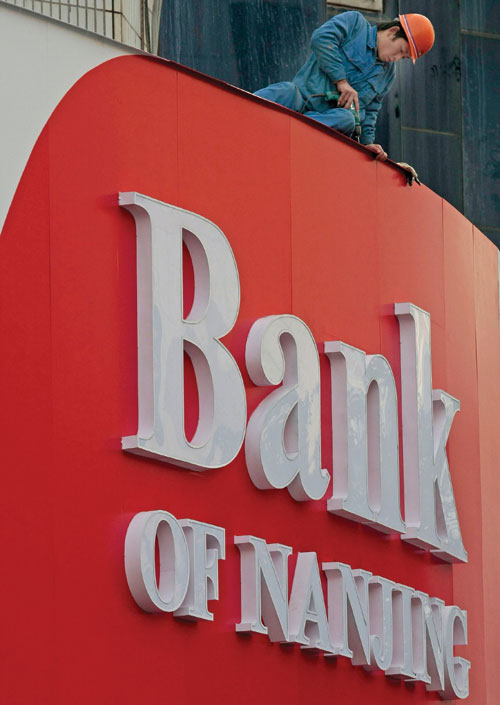Banks have record year amid economic troubles
Updated: 2012-02-21 10:07
By Wang Xiaotian (China Daily)
|
|||||||||||
BEIJING - Chinese banks reported record-high net profits in 2011, a year that saw manufacturers struggling with rising costs and tightened liquidity.
|
 |
|
A worker repairing a bank's signboard in Nanjing, Jiangsu province. The net profits of China's commercial banks rose 36.3 percent last year to more than 1 trillion yuan ($159.9 billion).[Photo/China Daily] |
According to data from the China Banking Regulatory Commission, Chinese commercial lenders had a net profit of more than 1 trillion yuan ($159.9 billion) in 2011, an increase of 36.3 percent from the year before.
They also reported net-interest income of 2.15 trillion yuan in 2011, up by 29.3 percent from the year before, and their non-interest income increased by 46.3 percent to reach 514.9 billion yuan.
Lenders' total assets reached 88.4 trillion yuan by the end of 2011, up 19.2 percent from a year earlier.
Chen Yongjie, deputy secretary of the China Center for International Economic Exchanges, said Chinese banks' net profit per capita is 12 times as large as that of manufacturers.
Although commercial banks still enjoy high profits, their rate of increase has fallen below what it had been in previous years, said Guo Tianyong, director of the Central University of Finance and Economics' research center.
"In 2005 and 2006, banks had a profit growth rate of between 50 and 60 percent," Guo said. "Some small and medium-sized lenders even reported a rate of 100 to 200 percent."
He said banks have enjoyed a near-monopoly and strong bargaining power. He said that has been the result both of the high barriers that stand before those who would enter the industry and the fact that interest rates have not been set in accordance with market forces.
"This period of huge banking profits might come to an end if we would encourage more players to come in and break up the monopoly and also further liberalize interest rates," Guo said.
Besides profits, banks have been eager to obtain capital, especially after they have watched their deposits drain and their equity financing plans postponed by regulators. Even so, it seems unlikely the China Banking Regulatory Commission will adopt higher capital requirements before the second half of the year.
Bad loans increase
The industry, meanwhile, has found itself under greater pressure as the amount of non-performing loans it holds increased in the fourth quarter.
By the end of 2011, their non-performing loan ratio stood at 0.96 percent, up by 0.01 percentage point from the third quarter. In the fourth quarter, the amount of their outstanding bad loans increased by 20.1 billion yuan.
UBS Securities Co Ltd, which provides securities brokerage services, earlier predicted that Chinese banks will face a capital shortfall of more than 220 billion yuan in 2012 and will need more than 295 billion yuan in 2013.
Local media reported that publicly listed lenders may raise more than 100 billion yuan through equity financing this year and that they are looking at sales of subordinated bonds as a good way to replenish their capital.
After pursuing aggressive refinancing in 2011, banks' average capital adequacy ratio reached 12.7 percent by the end of the year, 0.55 percentage point higher than it had been a year earlier and 0.39 point higher than three months ago.
Faced with rising pressure, banks have been reluctant to lend more, even as the central bank calls for more financial support to go to the real economy, the part of the economy involved in producing goods and services
Liu Ligang, head of Greater China economics at ANZ Banking Group, said banks brokered fewer loans than expected in the first 15 days of February. That, he said, was the chief reason the central bank's reserve requirement ratio was reduced on Saturday, a change regulators think will inject liquidity into the banking industry and encourage lending.
Senior officials at the China Banking Regulatory Commission have called on lenders to draw on their profits to replenish their capital rather than turning to external sources to accomplish that purpose.
The Central Huijin Investment Co, the State parent of China's "Big Four" banks, has agreed to reduce the dividend ratio of three State-owned lenders - Industrial and Commercial Bank of China Ltd, China Construction Bank and Bank of China Ltd. The ratio is to be lowered by 5 percentage points, taking it to 35 percent.
Related Stories
Agricultural policy bank to issue $60b in bonds 2011-03-11 09:19
PBOC plans overhaul of money policy 2011-02-11 07:46
China should stick to prudent monetary policy 2011-08-24 14:22
Purchase of bank shares helps market 2011-10-11 08:03
- Consumers seek accident, health insurance
- MOC tops central government transparency list
- Very little sweet news for sugar producers
- Sing, dance and buy for New Year
- Avon appoints new head of China business
- Banks have record year amid economic troubles
- Bank of China moves closer to LME membership
- CSRC tightens rules on acquisitions









